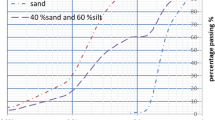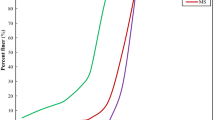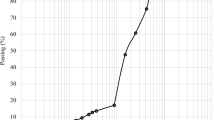Abstract
Water content is an important indicator of highway subgrade compaction, which has an impact on the engineering behaviors of pavement structures significantly. To study the influence of soil aggregation induced by water content variation on the engineering behaviors of silt subgrade, a series of laboratory experiments, including sieving analysis, unconfined compression tests and hydraulic conductivity tests, were conducted on the cement-treated silt subgrade. The influence of water content on the soil aggregation, unconfined compressive strength (UCS) and hydraulic conductivity were examined, respectively. The distribution range of UCS index (IUCS) and hydraulic conductivity index (Ik) were expressed accordingly. Test results demonstrate that when the water content lower than the optimum water content (wopt), the specimens are more homogeneous, the UCS increases regularly with the increase of curing time and water content, the hydraulic conductivity decreases regularly with curing time and water content increased. When the water content is higher than the wopt, the silt aggregation leads to the structural inhomogeneity of specimens, the strength decreases irregularly with the increase of curing time and water content, the hydraulic conductivity increases irregularly with the increase of curing time and water content accordingly. The soil aggregation induced by water content variation is proved to be a major reason for the ununiformly distribution of the UCS and hydraulic conductivity, the influence of which is more significant than that of binders when the water content higher than the wopt. Hence, controlling water content within 2% lower the wopt is strongly suggested to forming a more homogeneous structure of the subgrade.
Similar content being viewed by others
References
ASTM D2166 (2013) Standard test method for unconfined compressive strength of cohesive soil. West Conshohocken, PA, USA
ASTM D2487 (2011) Standard practice for classification of soils for engineering purposes (Unified Soil Classification System). West Conshohocken, PA, USA
ASTM D422 (2007) Standard test method for particle-size analysis of soils, american society for testing and materials. West Conshohocken, PA, USA
ASTM D4318 (2017) Standard test methods for liquid limit, plastic limit, and plasticity index of soils, american society for testing and materials. West Conshohocken, PA, USA
ASTM D4643 (2017) Standard test method for determination of water content of soil and rock by microwave oven heating. West Conshohocken, PA, USA
ASTM D4972 (2011) Standard test method for pH of soils. West Conshohocken, PA, USA
ASTM, Designation: D5084 (2004) Standard test method for measurement of hydraulic conductivity of saturated porous materials using a flexible wall permeameter. West Conshohocken, PA, USA
Ban H, Park SW (2014) Characteristics of modified soil-aggregate system and their application in pavements. KSCE Journal of Civil Engineering 18(6):1672–1678, DOI: https://doi.org/10.1007/s12205-014-0639-3
Bian X, Wang ZF, Ding GQ, Cao YP (2016) Compressibility of cemented dredged clay at high water content with super-absorbent polymer. Engineering Geology 208:198–205, DOI: https://doi.org/10.1061/(ASCE)MT.1943-5533.0001849
Bolscher T, Koestel J, Etana A, Ulen B, Berglund K, Larsbo M (2021) Changes in pore networks and readily dispersible soil following structure liming of clay soils. Geoderma 390:114948, DOI: https://doi.org/10.1016/j.geoderma.2021.114948
Cai Y, Shi B, Liu ZB, Tang CS, Wang BJ (2005) Experimental study on effect of aggregate size on strength of filled soils. Chinese Journal of Geotechnical Engineering 27(12):1482–1486 (in Chinese)
Chen RF, Cai GJ, Dong XQ, Mi DY, Puppala AJ, Duan W (2019) Mechanical properties and micro-mechanism of loess roadbed filling using by-product red mud as a partial alternative. Construction and Building Materials 216:188–201, DOI: https://doi.org/10.1016/j.conbuildmat.2019.04.254
Cheng J, Yu FW, Jia FJ (2017) Effect of aggregate size on stress-strain behavior of concrete confined by fiber composites. Composite Structures 158(2017):851–862, DOI: https://doi.org/10.1016/j.compstruct.2017.02.087
Ding JW, Shi ML, Liu WZ, Wan X (2019) Failure of roadway subbase induced by overuse of phosphogypsum. Journal of Performance of Constructed Facilities 33(2), DOI: https://doi.org/10.1061/(ASCE)CF.1943-5509.0001278
Ferreira TR, Pires LF, Wildenschild D, Brinatti AM, Borges J, Auler AC, dos Reisa AMH (2018) Lime application effects on soil aggregate properties: Use of the mean weight diameter and synchrotron-based x-ray µCT techniques. Geoderma 338, DOI: https://doi.org/10.1016/j.geoderma.2018.10.035
Flrat S, Yllmaz G, Cömert AT, Sümer M (2012) Utilization of marble dust, fly ash and waste sand (silt-quartz) in road subbase filling materials. KSCE Journal of Civil Engineering 16(7):1143–1151, DOI: https://doi.org/10.1007/s12205-012-1526-4
GB/T 50123-2019 (2019) Standard for soil test method. Ministry of Water Resources of the People’s Republic of China, China Planning Press, Beijing, China (in Chinese)
Heitor A, Indraratna B, Rujikiatkamjorn C (2012) Use of the soil modulus for compaction control of compacted soils [C] // International Conference on Ground Improvement and Ground Control. Wollongong, Australia: ICGI, 2012:1083–1088
Horabik J, Jozefaciuk G (2021) Structure and strength of kaolinite-soil silt aggregates: Measurements and modeling. Geoderma 382(48):114687, DOI: https://doi.org/10.1016/j.geoderma.2020.114687
Horpibulsuk S, Katkan W, Sirilerdwattana W, Rachan R (2006) Strength development in cement stabilized low plasticity and coarse grained soils: Laboratory and field study. Soils Foundations 46(3):351–366, DOI: https://doi.org/10.3208/sandf.46.351
Huo WW, Zhang WC, Zhu ZD, Peng YY (2021) Experimental and numerical simulation study on mechanical and engineering properties of silt roadbed under capillary water. Bulletin of Engineering Geology and the Environment 80(10):8211–8229, DOI: https://doi.org/10.1007/s10064-021-02427-8
Jia J, Wan Y, Liu H, Qi K, Zhang J (2019) Evaluation of compaction uniformity of the paving layer based on transverse and longitudinal measurements. International Journal of Pavement Engineering 22(187):1–13, DOI: https://doi.org/10.1080/10298436.2019.1600692
Kermani B, Stoffels SM, Ming X, Tong Q (2018) Experimental simulation and quantification of migration of subgrade soil into subbase under rigid pavement using model mobile load simulator. Journal of Transportation Engineering Part B Pavements 144(4), DOI: https://doi.org/10.1061/JPEODX.0000078
Liang WY, Yan RT, Xu YF, Zhang Q, Tian HH, Wei CF (2021) Swelling pressure of compacted expansive soil over a wide suction range - ScienceDirect. Applied Clay Science 203:15, DOI: https://doi.org/10.1016/j.clay.2021.106018
Liu LQ, Mao XS, Wu Q, Liu FF, Zhao Y (2019) Mechanism of groundwater migration in the subgrade in a seasonally frozen soil area. Journal of Cold Regions Engineering 33(4), DOI: https://doi.org/10.1061/(ASCE)CR.1943-5495.0000196
Ma Y, Zhang Y, Zhao W, Ding XM, Wang ZW, Ma T (2022) Assessment of intelligent compaction quality evaluation index and uniformity. Journal of Transportation Engineering, Part B: Pavements 148(2):04022024, DOI: https://doi.org/10.1061/JPEODX.0000368
MEE (2019) Annual report on the prevention and control of environmental pollution by solid waste in China. Ministry of Ecology and Environment of the People’s Republic of China, Beijing (in Chinese)
Pu SY, Zhu ZD, Huo WW (2021) Evaluation of engineering properties and environmental effect of recycled gypsum stabilized soil in geotechnical engineering: A comprehensive review. Resources, Conservation and Recycling 174, DOI: https://doi.org/10.1016/j.resconrec.2021.105780
Qing J, Cui XZ, Li J, Su JW, Wang YL (2020) In situ test and numerical analysis of traffic-load-induced cumulative settlement of alluvial silt after treatment with burnt lime. International Journal of Geomechanics 20(2), DOI: https://doi.org/10.1061/(ASCE)GM.1943-5622.0001571
Quintus V (2009) Nondestructive testing technology for quality acceptance of flexible pavement construction. NCHRP Report 10–65. National Research Council
Quintus V, Rao C, Stubsad RN (2006) Nondestructive testing technology for quality control and acceptance of flexible pavement construction. Unpublished Interim Report-Phase II Part A Testing. NCHRP Project 2006:10–65
Stocker PT (1974) Diffusion and diffuse cementation in lime and cement stabilized clayey soils-studies of plasticity and aggregation. Australian Road Research 5(6):51–75
Vanapalli SK, Fredlund DG, Pufahl DE, Clifton AW (1996) Model for the prediction of shear strength with respect to soil suction. Canadian Geotechnical Journal 33(3):379–392, DOI: https://doi.org/10.1139/t96-060
Wan X, Ding Jw, Jiao N, Mou C, Gao MY (2022) Mechanical and microstructural properties of cement-treated marine dredged clay with red mud and phosphogypsum. Bulletin of Engineering Geology and the Environment 81(7):1–13, DOI: https://doi.org/10.1007/s10064-022-02753-5
Wang YJ, Cui YJ, Tang AM, Benahmedc N, Duc M (2017) Effects of aggregate size on the compressibility and air permeability of lime treated fine-grained soil. Engineering Geology 228:167–172, DOI: https://doi.org/10.1016/j.enggeo.2017.08.005
Wu J, Deng YF, Zhang GP, Zhou AN, Tan YZ, Xiao HL, Zheng QS (2021) A generic framework of unifying industrial by-products for soil stabilization. Journal of Cleaner Production 321, DOI: https://doi.org/10.1016/j.jclepro.2021.128920
Wu J, Liu QW, Deng YF, Yu XB, Feng Q, Yan C (2019) Expansive soil modified by waste steel slag and its application in subbase layer of highways. Soils and Foundations 59(4):955–965, DOI: https://doi.org/10.1016/j.sandf.2019.03.009
Xiao T, Li P, Pan Z, Hou Y, Wang J (2022) Relationship between water retention capacity and pore-size distribution of compacted loess. Journal of Soils and Sediments 22(12):3151–3165, DOI: https://doi.org/10.1007/s11368-022-03278-w
Zhang J, Han Y, Wang X, Bian H (2021a) Experimental investigation of the dynamic characteristics of treated silt using lignin: Case study of yellow river flood basin. International Journal of Geomechanics 21(5):04021056, DOI: https://doi.org/10.1061/(ASCE)GM.1943-5622.0002018
Zhang JY, He ZL, Feng J (2021b) Frost damage improvement for railway subgrade based on ground temperature control in cold regions, KSCE Journal of Civil Engineering 25(8):2911–2921, DOI: https://doi.org/10.1007/s12205-021-2197-9
Zhang S, Ding JW, Lai ZY, Guo QY, Wan X (2023) Mechanical and microstructural properties of silt roadbed filling improved with cement, red mud and desulfurization gypsum. European Journal of Environmental and Civil Engineering, DOI: https://doi.org/10.1080/19648189.2023.2206461
Acknowledgments
This study is partially supported by the National Natural Science Foundation of China (Grant No. 51978159), National Key R&D Program of China (Grant No. 2015BAB07B06). The authors are grateful to Mr. Zhenyuan Lai for his hard work in the laboratory tests and Ms. Chen Guo for technical writing check of this paper, which are essential to the successful completion of this manuscript.
Author information
Authors and Affiliations
Corresponding author
Rights and permissions
About this article
Cite this article
Zhang, S., Ding, J., Lai, Z. et al. The Influence of Soil Aggregation Induced by Water Content Variation on the Engineering Behaviors of Cement-Treated Silt Subgrade. KSCE J Civ Eng 27, 4192–4204 (2023). https://doi.org/10.1007/s12205-023-3192-0
Received:
Accepted:
Published:
Issue Date:
DOI: https://doi.org/10.1007/s12205-023-3192-0




